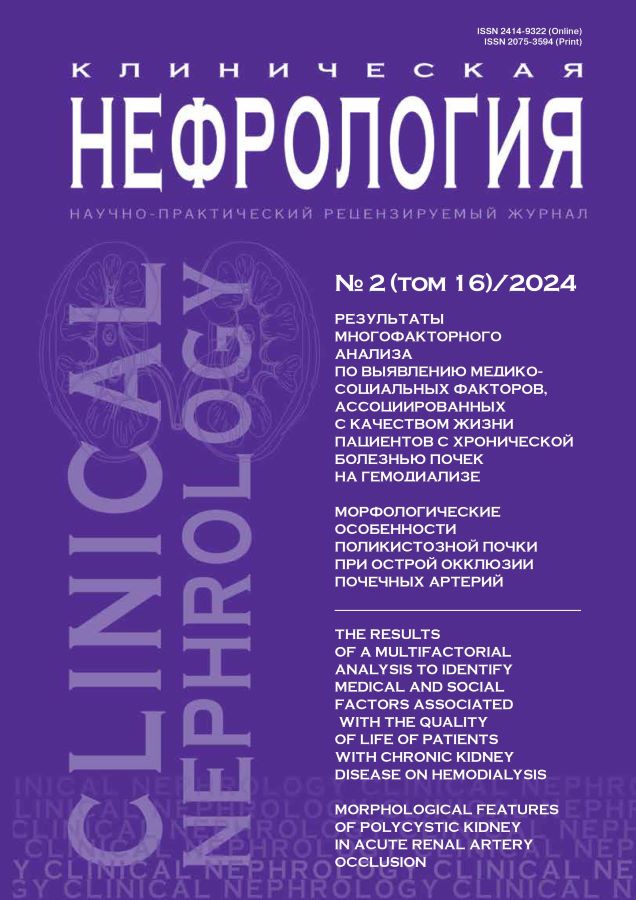Трудности диагностики и лечения атипичного гемолитико-уремического синдрома: клинический случай
- Авторы: Бахарева Ю.С.1, Чапаева Н.Н.2
-
Учреждения:
- Научно-исследовательский институт терапии и профилактической медицины – филиал ФГБНУ «Федеральный исследовательский центр “Институт цитологии и генетики Сибирского отделения Российской академии наук”
- ФГБОУ ВО «Новосибирский государственный медицинский университет» Минздрава РФ
- Выпуск: Том 16, № 2 (2024)
- Страницы: 58-60
- Раздел: Наблюдения из практики
- URL: https://journals.eco-vector.com/2075-3594/article/view/634554
- DOI: https://doi.org/10.18565/nephrology.2024.2.58-60
- ID: 634554
Цитировать
Полный текст
Аннотация
Атипичный гемолитико-уремический синдром (аГУС) представляет собой заболевание с неконтролируемой активацией альтернативного пути комплемента, ведущей к развитию комплемент-опосредованной тромботической микроангиопатии (ТМА). Типичная триада аГУС – острое повреждение почек (ОПП), неиммунная гемолитическая анемия, тромбоцитопения потребления.
Цель: продемонстрировать трудности диагностики и лечения аГУС.
Клинический случай. У пациента Д. 19 лет резко развивается ОПП после принесенной вирусной инфекции. Симптомы, характерные для аГУС: анемия, тромбоцитопения и ОПП. Обсуждение диагноза ТМА в рамках аГУС стало возможным благодаря результатам обследования пациента на ADAMTS-13, полного восстановления почечной функции на фоне плазмотерапии.
Заключение. Крайне важна информированность врачей о возможностях своевременной диагностики аГУС, адекватная патогенетическая терапия позволяет полностью восстанавливать функцию пораженных органов.
Полный текст
Об авторах
Юлия Сергеевна Бахарева
Научно-исследовательский институт терапии и профилактической медицины – филиал ФГБНУ «Федеральный исследовательский центр “Институт цитологии и генетики Сибирского отделения Российской академии наук”
Автор, ответственный за переписку.
Email: 8578511@inbox.ru
ORCID iD: 0000-0003-0480-1510
м.н.с., лаборатория клинико-популяционных и профилактических исследований терапевтических и эндокринных заболеваний
Россия, НовосибирскНаталья Николаевна Чапаева
ФГБОУ ВО «Новосибирский государственный медицинский университет» Минздрава РФ
Email: n.chapaeva@mail.ru
ORCID iD: 0000-0003-0907-5044
д.м.н., профессор кафедры госпитальной терапии
Россия, НовосибирскСписок литературы
- Talarico V., Aloe M., Monzani A., et al. Hemolytic uremic syndrome in children. Minerva Pediatr. 2016;68(6): 441–55.
- Crawford B., Strebeck P., Saccente S. Constipation and hemolytic uremic syndrome. Pediatr. Nephrol. 2024;39(2):603–07. doi: 10.1007/s00467-023-06093-8.
- Viteri B., Saland J.M. Hemolytic Uremic Syndrome. Pediatr. Rev. 2020;41(4):213–15. doi: 10.1542/pir.2018-0346.
- Yerigeri K., Kadatane S., Mongan K., et al. Atypical Hemolytic-Uremic Syndrome: Genetic Basis, Clinical Manifestations, and a Multidisciplinary Approach to Management. J. Multidiscip. Healthc. 2023;16:2233–49. doi: 10.2147/JMDH.S245620.
- Leon J., LeStang M.B., Sberro-Soussan R., et al. Complement-driven hemolytic uremic syndrome. Am. J. Hematol. 2023;98(4): 44–56. doi: 10.1002/ajh.26854.
- Spasiano A., Palazzetti D., Dimartino L., et al. Underlying Genetics of aHUS: Which Connection with Outcome and Treatment Discontinuation? Int. J. Mol. Sci. 2023;24(19):14496. doi: 10.3390/ijms241914496.
- Fakhouri F., Schwotzer N., Frémeaux-Bacchi V. How I diagnose and treat atypical hemolytic uremic syndrome. Blood. 2023;141(9): 984–95. doi: 10.1182/blood.2022017860.
Дополнительные файлы








